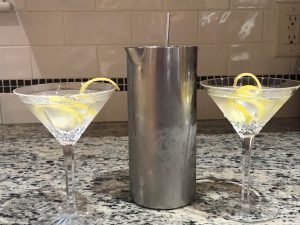
INSIDE THIS EDITION:
- From the Memoir Class: THE PERFECT MARTINI OR CONFESSIONS OF A MARTINI SNOB by Bill Hudson; MY CLASS OBITUARY by Catherine Cochran
- THE CULTURE CORNER: Aurea Premiere: TREE OF THE WORLD (Apr 27); THIRD ANNUAL SAKONNET PLANT FAIR (May 4); RI Center for Photographic Arts AI, PHOTOREALISM AN OTHER IMAGES THAT FOOL THE EYE – Opening Reception May 16; Exhibit through June 14; LitArts RI PODCAST LISTENING PARTY (Apr 20)
- KEY DATES FOR LLC'S SUMMERSESSION AND BEYOND
- I WANDERED LONELY AS A CLOUD by William Wordsworth
Click on the links to jump to the article.
From the Memoir Class
The Perfect Martini or Confessions of a Martini Snob
by Bill Hudson
My Pop introduced me to the martini ritual. He was part of the post-WWII generation that enjoyed their cocktails, particularly martinis. Unlike some of his contemporaries, I do not think that he participated in many “three martini lunches”. He normally ate the lunch he brought from home at his desk. Nor, when we were growing up, did my parents consume a martini before dinner – such a practice, given the price of hard liquor, would have offended their frugality. Martini drinking was reserved for parties and special occasions, like visits from my Aunt Mildred, Mom’s twin sister, and Uncle Lee. Uncle Lee enjoyed his cocktails and, as an executive with a large company, was not a stranger to “three martini lunches”. Whenever my uncle and aunt would visit, Uncle Lee would remove several bottles of gin and one of vermouth from his trunk and pre-prandial martinis would flow.
Sometime after my sister and I had left home for college, with the family budget less tight, my parents began the ritual of a pre-dinner cocktail hour. Whenever I would visit, they would enjoy a Manhattan or a Martini before we ate dinner. After I turned twenty-one, Pop introduced me to the martini.
I remember Pop placing two parts Gordon’s Gin and one part Vermouth in a shaker full of ice, mixing slowly with a spoon until the shaker was well frosted, pouring the now icy contents into small 4-ounce glasses and garnishing with an olive. He handed me a glass and I took a sip and experienced for the first time the delight of this cold beverage flowing across my tongue. I had become a martini lover.
Pop’s 2-1 ratio of gin to vermouth was once the classic recipe for a “dry martini.” Nowadays, when martinis at a bar or restaurant contain a much smaller quantity of vermouth, if any, this two to one ratio would be considered a very “wet.” Martini recipe books recommend a 4-1 ratio for a standard martini and a smaller ratio for a “dry” martini. I now use a 5 or 6 -1 ratio for my martinis.
So much for the nostalgia, here comes the snobbery. Sadly, many today have come to believe that vermouth is unnecessary in a martini. Today, when I order a martini at a bar, I often must remind the bartender to add some vermouth, sometimes receiving disdainful stares as I do so. For young bartenders, the default seems to be to make a martini with gin alone, either because that is what they assume the customer expects or because that is how they have been taught. The ignorance on this score seems immense. Once when I asked a young bartender to add some vermouth, he reached for a bottle of rosso vermouth. Disaster was avoided only because I somewhat rudely instructed him to put it down and get a proper dry vermouth.
Let me state without equivocation: gin without vermouth is not a martini. Now some may prefer a drink made of ice-cold gin alone, I do not begrudge them that preference, but that drink is not a martini. From its invention around 1900, either in San Francisco or New York City, martinis have included dry gin and dry vermouth. For anyone with a decent martini palate, the subtle mixing of the gin and vermouth give the drink its special flavor. The proportions can vary – that is a matter of preference, but at least some vermouth is essential to the drink. Why the current fashion for so-called martinis without gin? Perhaps it stems from an apocryphal story that Winston Churchill would mix his martinis with gin alone while merely looking at a bottle of vermouth. More likely, the fashion stems from a mistaken belief that martinis derive all their flavor from the type of gin, and there are many available nowadays, so that vermouth does not matter. Or, perhaps, even more simply, for those ignorant of the history of the “dry martini”, adding dry vermouth is thought to diminish the drink’s “dryness”.
Shaken or stirred? I believe that a good martini can be made either way. Most bartenders shake their martinis. This may be to impress the customer with a dramatic flourishing of the ice-filled shaker over the bartender’s head. Shaking also has utilitarian value in a busy bar because it allows chilling the drink more quickly than stirring. When making my martinis at home, I prefer to stir them slowly in a metal shaker filled with ice for close to one minute. This allows some slight melting of the ice which facilitates the merging of the gin and vermouth. Once the outside of the shaker is well frosted and icy cold to the touch, the martinis are ready to pour. Stirring also prevents a common side effect of vigorously shaken martinis: a layer of crushed ice on the drink’s surface.
Types of gin? We live in an age of proliferation of liquor varieties of all kinds. New specialty varieties of bourbons, rye whiskies, rums, vodkas, Irish whiskies, scotches, etc. are being produced constantly. Many are manufactured in small batches and sold at astronomical prices. The same is true of gin. A visitor to an upscale liquor store nowadays will find a plethora of different brands of gin on display. Most have exotic names and feature equally exotic botanicals to supplement the basic flavor of the juniper berry that makes the liquor a gin. I sometimes like to sample these new-fangled products in a martini, but my preference remains for the more standard brands that continue to dominate the gin market, such as Beefeater, Gordons, Bombay, and Tanqueray, my favorite. The slight citrus flavor of Tanqueray makes for a very tasty martini.
 Garnish? There are a variety of appropriate garnishes for a martini. A small pearl onion makes a “Gibson” martini. For a martini made with Hendricks gin a slice of cucumber compliments well the mix of botanicals that give it a distinct flavor. The olive, of course, remains the typical martini garnish. I like one olive in any martini consumed between Labor Day and Memorial Day, but for the summer prefer a twist of lemon rind for a perfect cool beverage on a hot day. The lemon twist goes quite well with the already citrusy Tanqueray gin.
Garnish? There are a variety of appropriate garnishes for a martini. A small pearl onion makes a “Gibson” martini. For a martini made with Hendricks gin a slice of cucumber compliments well the mix of botanicals that give it a distinct flavor. The olive, of course, remains the typical martini garnish. I like one olive in any martini consumed between Labor Day and Memorial Day, but for the summer prefer a twist of lemon rind for a perfect cool beverage on a hot day. The lemon twist goes quite well with the already citrusy Tanqueray gin.
Martini glass? The proper glass for a martini is the classic funnel shape bowl above a long stem, preferably chilled in a freezer or, second best, chilled by filling with ice and water for a few minutes before use. Martini glasses nowadays hold from 6 to 8 ounces of liquid. These are much larger than the 4-ounce glasses dominant in the heyday of martini culture from the 1930’s to the 1960’s. If you watch a movie from the 30’s or 40’s, in which martinis play a role such as the Thin Man movies or The Philadelphia Story, the martinis are served in these smaller glasses. Nick and Nora could down martini after martini without passing out, as they solved a murder, because they were drinking much less than they would have drinking from the modern larger pours. The 1950s three martini businessman’s lunch may not have destroyed the American economy because our captains of industry went back to work have consumed only 1 and ½ of a modern martini serving.
 In the past few years, many bars and restaurants have replaced the classic funnel shaped martini glass with a round coupe shaped glass. This is a disappointing development. Somehow a martini does not taste the same in a glass better suited for chocolate mousse. I have asked several bartenders about why this shift to the round glasses and have received the same answer. It seems that the funnel shaped glasses are prone to break in the glassware dishwashers used in most bars. For some reason, the coupe glasses are more stable. Happily, our favorite Providence restaurant, although it has joined the shift to coupe glasses, keeps some classic funnel shaped ones on hand for whenever my wife and I come in. Nice to have a place where everyone knows your name.
In the past few years, many bars and restaurants have replaced the classic funnel shaped martini glass with a round coupe shaped glass. This is a disappointing development. Somehow a martini does not taste the same in a glass better suited for chocolate mousse. I have asked several bartenders about why this shift to the round glasses and have received the same answer. It seems that the funnel shaped glasses are prone to break in the glassware dishwashers used in most bars. For some reason, the coupe glasses are more stable. Happily, our favorite Providence restaurant, although it has joined the shift to coupe glasses, keeps some classic funnel shaped ones on hand for whenever my wife and I come in. Nice to have a place where everyone knows your name.
Vodka? We are entering true snob territory. Some people like a drink made with vodka and vermouth “shaken, not stirred” a la James Bond. This drink IS NOT A MARTINI!!! From its inception at the start of the 20th century, martinis were always made with gin. Its popularity rose in the 1920s, during Prohibition – the era of bathtub gin. Sometime in the late 1950s or early 60s, when more vodka began to be imported to the United States, people began mixing it with a little vermouth and serving it cold in martini glasses. Many call this a vodka martini. This was a grave error. It led to the emergence of further “tini” heresies like the “appletini”, the peach martini, the chocolate martini, and so forth. I do not condemn the pleasure derived from any of these drinks. I celebrate diversity in tastes. Anyone should be perfectly free to mix some vodka with vermouth, fruit juice, or any other liquid and drink it, if one wishes, from a martini glass. Just do not call the drink a martini. “What’s in a name” you might ask? Precision and suitability, I would answer. The name martini ought to be reserved for the venerable beverage consisting of gin and vermouth. Attaching the name to other beverages, particularly of the vodka variety, sows confusion.
I am not a fanatic. Some of my best friends drink what they call a “vodka martini”. I do not lecture them. When one visits and requests a vodka martini, I am happy to mix one up and serve it with a smile. All the time, martini snob, that I am, I relish my superiority in secretly knowing that my guest is not drinking a martini. This, of course, is the height of snobbery. It is my sin.
Enough snobbery, back to nostalgia.
My cousin Kay told me recently that whenever my family was due to visit, her father, my Uncle Paul who rarely drank hard liquor, would say: “Kenny Hudson is coming, better go to the liquor store.” He would soon return with a bottle of gin, one of vermouth, and a jar of pimento filled olives. While we visited, my Uncle Paul would happily join in the consumption of the martinis my dad would mix. Once we departed, any leftover gin and vermouth would go into the pantry to await Kenny’s next visit.
Occasionally, in memory of father, I make a martini just like the ones he used to make: two jiggers of gin and one of vermouth, stirred well, and served in a small 4-ounce glass. As I sip that martini, I remember warm evenings sitting with him on the back patio of my folk’s house in California, looking out at the setting sun shining on the avocado groves in the distance, discussing and solving the world’s problems, and sipping one of his martinis. Those were perfect martinis.

The Memoir Class had an interesting prompt offered during the Winter Semester:
Create your own obituary.
My Class Obituary
By Catherine Cochran
Catherine Anne Cochran from North Providence passed away recently while outdoors; however, it is still unclear whether she was in the woods, at the beach, or simply attempting to snap moon pictures in her own back yard, but it is quite likely that she was chatting with someone at the time of her passing.
As Catherine was a little late to her Celebration of Life Ceremony and has not yet arrived at the “boarding gate,” apparently St. Peter has submitted a work order to send someone to help her with directions. Despite her passing, her arrival remains in progress at this time.
Catherine had many nicknames throughout her life; Cathy, Cate, Catrina; perhaps her favorite was the one given to her by her five-year old neighbor when she mistakenly began calling her Valentina, which was the name of Catherine’s eleven-year old Labbie.
Catherine loved to bake, but when it came to cooking on a consistent basis, she was treated to many dinners out and seemed to make friends easily at both the Honey Dew and Dunkin Donut drive-through windows.
 She lived in a city in a small house that she lovingly named “The Urban Cottage” which over the years was filled with yarn, books, various Job Lot and Christmas Tree Shop artifacts, and of course her beloved dogs and cats, and wild yard bunny named “bun bun.”
She lived in a city in a small house that she lovingly named “The Urban Cottage” which over the years was filled with yarn, books, various Job Lot and Christmas Tree Shop artifacts, and of course her beloved dogs and cats, and wild yard bunny named “bun bun.”
While Catherine remained single throughout her life, that didn’t stop her from adventure and going on some interesting dates, which included a man who introduced himself while dressed as Superman, a man with a “bean phobia,” and a romantic sail to Cutty Hunk which included a handsome sailor and a rocking boat.
 Catherine had a lot of interests, and while not planned, fell into the work of advocating for children and families. Her dream was to open an activity center to foster community and create a safe place to bring families together, perhaps using a repurposed camper to bring activities and resources in to the community.
Catherine had a lot of interests, and while not planned, fell into the work of advocating for children and families. Her dream was to open an activity center to foster community and create a safe place to bring families together, perhaps using a repurposed camper to bring activities and resources in to the community.
Above all else, Catherine was known to have a kind heart and to find fulfillment wherever she was.
In lieu of flowers and donations, mourners are being encouraged to have a party, sip a cocktail, eat some cake, plant trees and flowers, and of course, walk barefoot on the beach and, as always, strive to be kind.

THE CULTURE CORNER


Please join us for an Aurea Premiere:
Tree of the World
April 27 @ 8 PM
St. Martin's Episcopal Church
50 Orchard Ave, Providence, RI
International pipa virtuoso, Yang Wei, returns for a poignant new collaboration celebrating the confluence of eastern and western cultures and the universality of the human condition. Music of Bright Sheng, Tan Dun, Caroline Shaw, J.S. Bach, Debussy, and Chris Turner’s mesmerizing harmonica improvisations, merge with words from ancient times to the present, revealing surprising connections.
Acclaimed actor, Nigel Gore, and harmonica virtuoso, Chris Turner, underscore the program with spoken word and improvisations, sharing classic works by Zhang Heng, Buson and haiku poet, Ryota Oshima, and contemporary poems by Li Shangyu, Amina Saïd, and Billy Collins.
Nigel Gore and Chris Turner


Matthew Vera – Violin
Sarah Whitney – Violin
Consuelo Sherba – Viola
Emmanuel Feldman – Cello

RI Center for Photographic Arts
128 North Main Street, Providence
An exhibit of Artificial Intelligence (AI), photorealism, and other images that fool the eye
Thursday, May 16-Friday, June 14
The opening reception is May 16 from 5-8 PM.
LitArts RI: Community and Support for Rhode Island Writers
LitArts RI, formerly What Cheer Writers Club, supports Rhode Island's creators of the written, spoken and illustrated word through community events, free and low-cost business services and coworking space.
Podcast Listening Party
Saturday, April 20 @ 3-5 PM
litartsri.org
Key Dates for LLC's Summersession 2024 and Beyond
Monday, May 6:
Look for our catalog announcement email
Monday, May 13:
Registration opens at 9 AM
Week of June 17:
Classes begin
Plus:
Several members have asked for the future schedule so they can do some general planning. An approximate schedule is that future classes begin around January 9, March 20, June 17, and September 11.


I Wandered Lonely as a Cloud
William Wordsworth
I wandered lonely as a cloud
That floats on high o'er vales and hills,
When all at once I saw a crowd,
A host, of golden daffodils;
Beside the lake, beneath the trees,
Fluttering and dancing in the breeze.
Continuous as the stars that shine
And twinkle on the milky way,
They stretched in never-ending line
Along the margin of a bay:
Ten thousand saw I at a glance,
Tossing their heads in sprightly dance.
The waves beside them danced; but they
Out-did the sparkling waves in glee:
A poet could not but be gay,
In such a jocund company:
I gazed—and gazed—but little thought
What wealth the show to me had brought:
For oft, when on my couch I lie
In vacant or in pensive mood,
They flash upon that inward eye
Which is the bliss of solitude;
And then my heart with pleasure fills,
And dances with the daffodils.

